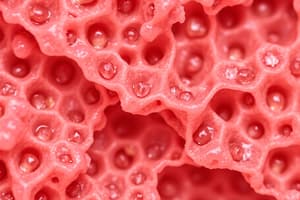Podcast
Questions and Answers
Which of the following types of epithelial tissues is characterized by flat, scale-like cells?
Which of the following types of epithelial tissues is characterized by flat, scale-like cells?
- Columnar epithelium
- Stratified cuboidal epithelium
- Cuboidal epithelium
- Simple squamous epithelium (correct)
Which type of connective tissue is primarily responsible for transporting nutrients and oxygen throughout the body?
Which type of connective tissue is primarily responsible for transporting nutrients and oxygen throughout the body?
- Bone
- Blood (correct)
- Adipose tissue
- Cartilage
What type of muscle tissue is responsible for voluntary movements in the body?
What type of muscle tissue is responsible for voluntary movements in the body?
- Smooth muscle
- Skeletal muscle (correct)
- Involuntary muscle
- Cardiac muscle
Which of the following tissues is specialized for signal transmission in the body?
Which of the following tissues is specialized for signal transmission in the body?
What is the primary characteristic that distinguishes sclerenchyma tissue from parenchyma and collenchyma in plants?
What is the primary characteristic that distinguishes sclerenchyma tissue from parenchyma and collenchyma in plants?
What is the main function of stomata in plants?
What is the main function of stomata in plants?
What distinguishes cardiac muscle from other types of muscle tissue?
What distinguishes cardiac muscle from other types of muscle tissue?
Which of the following tissues is responsible for connecting muscles to bones?
Which of the following tissues is responsible for connecting muscles to bones?
In which areas of plants are parenchyma tissues typically found?
In which areas of plants are parenchyma tissues typically found?
Which tissue serves as a protective barrier in plant structures?
Which tissue serves as a protective barrier in plant structures?
Flashcards are hidden until you start studying
Study Notes
Tissues
- Tissues are categorized based on their structure and function.
- Epithelial tissues are classified into squamous, cuboidal, and columnar.
- Connective tissues include blood, bone, cartilage, and adipose tissue.
- Muscle tissue is categorized into skeletal, smooth, and cardiac.
- Nervous tissue is composed of neurons and allows for signal transmission.
Simple vs. Complex Tissues in Plants
- Simple tissues are made up of one type of cell.
- Complex tissues are made up of different types of cells.
Plant Tissues Based on Cell Wall
- Parenchyma tissues have thin cell walls and are involved in storage, photosynthesis, and gas exchange.
- Collenchyma tissues have unevenly thickened cell walls providing support and flexibility to growing plant parts.
- Sclerenchyma tissues have thick and rigid cell walls for structural support and protection.
Stomata Function
- Stomata are small pores on the surface of leaves that regulate gas exchange and transpiration.
Types of Muscle Fibers
- Skeletal muscle fibers are striated, voluntary, and attached to bones for movement.
- Smooth muscle fibers are unstriated, involuntary, and found in internal organs like the digestive tract.
- Cardiac muscle fibers are striated, involuntary, and found only in the heart.
Cardiac Muscle Function
- Cardiac muscle is responsible for the rhythmic contractions of the heart, pumping blood throughout the body.
Muscle Tissue Comparison
- Skeletal muscle is attached to bones and responsible for voluntary movement.
- Smooth muscle is found in internal organs and responsible for involuntary movements like digestion.
- Cardiac muscle is found only in the heart and responsible for rhythmic contractions to pump blood.
Neuron Structure
- Neurons are composed of a cell body, dendrites, and an axon.
- Dendrites receive signals from other neurons.
- The axon transmits signals to other neurons or target cells.
Tissue Types
- Skin is composed of epithelial tissue.
- Plant bark is made up of complex tissue, including cork and parenchyma.
- Bone is a type of connective tissue.
- Kidney tubule lining is composed of epithelial tissue.
- Vascular bundles are complex tissues in plants, containing xylem and phloem.
Parenchyma Tissue Regions
- Parenchyma tissues are found in various regions of plants, including the cortex, pith, and mesophyll.
Epidermis Function
- The epidermis is the outermost layer of plant tissues, protecting the plant from environmental stress.
Bark (Cork) as Protective Tissue
- Bark acts as a protective layer to prevent water loss, protect from herbivores, and resist infection.
Permanent Tissue Table
| Permanent Tissue | Simple | Complex |
|---|---|---|
| Parenchyma | X | |
| Collenchyma | X | |
| Sclerenchyma | X | |
| Xylem | X | |
| Phloem | X |
Studying That Suits You
Use AI to generate personalized quizzes and flashcards to suit your learning preferences.



